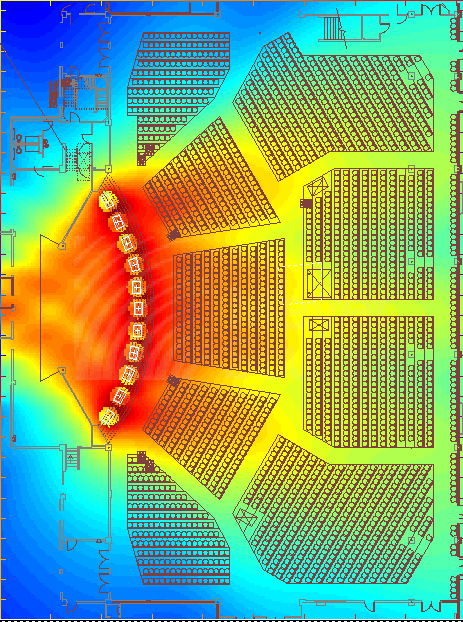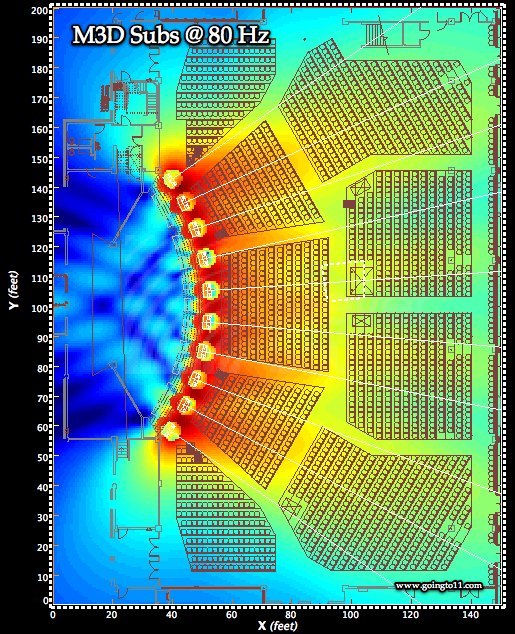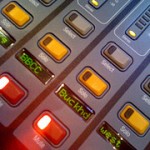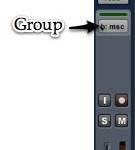
NP Live 2009 – Day 3/4: Boom Boom Boom

So the night of the recording went well, and while I can’t say that the day leading up the night was one of the finest, the week leading up to it was awesome. Plus most folks seemed like they had a good time for the night so overall I would say the whole thing was a success.
As I mentioned earlier, we once again brought in subs to see how they would play in our room. We brought in 12 Meyer 700HP’s in May to use for the Drive Conference, but this time we opted for 10 Meyer M3D subs. I was really happy with the 700’s at Drive, and the first photo here shows a heat plot for 11 700HP’s roughly in the configuration we had for Drive. Once again, the number of subs has nothing to do with power. It’s all about pattern control. By wrapping around the stage, we get very even coverage across the room. Once you add in wall reflections, what we had at Drive even filled in those cooler sections on the front sides. People can be very finicky about low end, but I’ve been pleasantly surprised at how much better things have been received by using this configuration.
However, one thing you’ll notice with this setup is how much low frequency energy there is on stage. It wasn’t the end of the world for the band when we had these setup at Drive. However, in our typical operation this poses a problem. Our two auditoriums have their stages back to back so on the wall directly behind the stage is another stage, and unfortunately all that energy carries over onto that other stage and into the audience listening area. With two auditoriums running simultaneously ever Sunday, this isn’t an optimal setup. Reports from the west during Drive was they were getting a good workout.
Thankfully there is a potential solution to this: cardioid subs. While traditional subs tend to radiate energy in an almost omni-directional pattern, cardioid subs are configured to cancel in the rear. This is usually achieved by facing a sub in the opposite direction and using the reversed polarity to achieve cancellation. While it is possible to array traditional subs in a fashion that will create a cardioid coverage pattern, it is unfortunately not feasible for us in our current space so the only thing we can really do is look at single enclosures that do the same thing. For the CD Project, we opted to try directional subs to compare against the 700HP’s.
The M3D sub is basically 2 subs in one. There are 2 forward firing 18’s with 2 rear-firing 15’s, and when you try and lift one you really get a sense of everything that’s in the box. They are incredibly heavy weighing just shy of 400 lbs. Load-in was….fun….

The second photo here shows the same prediction as the first with the M3D subs in the configuration we had for the CD Project. Again, you can see how even the coverage pattern is, but the main thing to note is the decreased energy on the stage. In practice this was true along with greatly reduced energy in our west auditorium which was a win. The reduction on stage also didn’t seem to bother the band.
Now, in my personal opinion, I preferred the 700HP’s. The 700’s just seemed like they were a little punchier. Going with the M3D subs, however, was barely a compromise. In fact, I received several comments from folks who preferred the M3D’s to the 700’s. Everyone has different tastes, I guess. The output of the M3D subs was also less than the 700’s, but there was still plenty for the room, and I do think the coverage was a little bit more even with only 10 of the M3D subs. If we were going to do something permanent, the lesson learned from the test is that we will definitely need to go with directional subs to make our Sunday programming work.
One last thing to note is once again the sound of our tops was greatly improved with the substitution of the Meyer subs for our current ones. The nice thing about using them this time is I had them right from the beginning of rehearsal where the Drive subs came in the night before. Having them from day one probably made also had an impact in the final mix result since I had 3 days on them instead of less than 24 hours. It was once again sad to them go.

 Previous Post
Previous Post Next Post
Next Post



I know the shape of the stage is some of the reason… but did you experiment with other configurations of the subs?
We’ve tried some different configurations over the years. This is the one we’ve grown to prefer. When you do start arc’ing subs like that, you can smear some of the transient, but it’s something I can live with if the coverage is even across the room. I don’t think most people would have even noticed.
have you been reading any of Dave Rat’s blogs? …. he’s doing some interesting things with subs. http://ratsound.com/cblog/
I have been following Dave Rat’s blog, and I think it is much more challenging to provide low end coverage for an arena than it is for my rooms. I’ve done some modeling of some of the stuff he’s done, and it doesn’t work for what we would like in our room, but I would love to hear how it sounds at one of his shows.
I think one of the big challenges in my room is that the mix position is not in the center of the room so once you move the subs beyond 7′ acoustic centers the comb filtering automatically puts the mix position in a null. And when the mixer isn’t getting hit as hard as some of the spots in the rest of the room, it is always going to be hard for him to get it right. You can walk around the room and get a feel for things over time, but I don’t think it’s a substitute for putting the mix position where the mixer will get maximum summation of all frequencies.
I’ve been in debates about this on whether FOH should be in the “best” spot dead center or if it should be off to give him an idea of what the average listener is going to experience. I lean towards putting the mixer dead center because if he’s going to be making tonal decisions for the entire room, he should have the absolute best perspective to make those calls. It is the system designers responsibility to replicate that “best” seat as much as possible throughout the rest of the room. There’s a reason why the big chair FOH guys sit dead center when they mix, and there’s a reason why guys mixing records sit in the sweet spot in the studio.
Since our FOH is off center, I think it’s almost essential that we get the most even sub coverage we can on the floor so that our FOH guys aren’t cranking the subs beating some poor guy to death because the FOH guys is mixing in a hole in the coverage.
We have all kinds of issues providing the low end at our two campuses. Thanks for sharing.
Dave,
You should really turn the walls on in the MAPP plots, as it is much more revealing. Even in a room as large as yours, the Schroeder frequency is still going to be somewhere in the meaningful sub bandpass. The plots of the type above in MAPP are essentially worthless anywhere near the Schroeder frequency, as the room’s modal density is insufficient to support the validity of the phasor sum condition MAPP is using above.
Sadly, MAPP does NOT show room modes correctly as it only works in 2d, and does not solve the eigenmodes of the full 3d space. The modes of a 2d slice of a 3d space are not in the same locations as the 3d space.
Regardless, one thing you will see is that the broadly distributed sub array is much more effective at exciting all of the room modes that exist. This is critical to the even distribution of LF below the Schroeder frequency.
Because of superposition the loudspeaker must be near an anti-mode if it is to effectively couple with that particular mode, and excite it in the room. With a large spatial distribution of loudspeakers, the probability of intercepting a large fraction of the room anti-nodes increases.
Also, since many room modes in rectangular spaces terminate along boundaries, or in corners, it is often advantageous to place an additional LF box in the locations with moderate output to help smooth the modal variations throughout the space.
Food for thought…